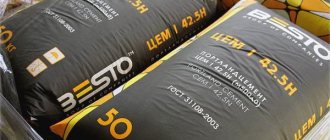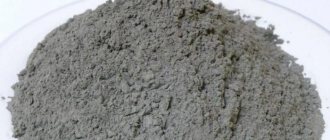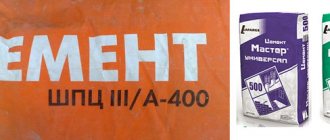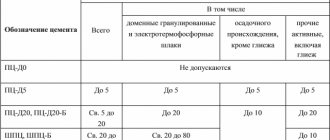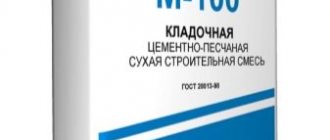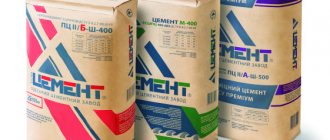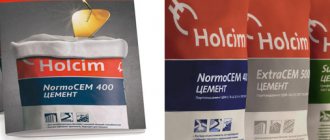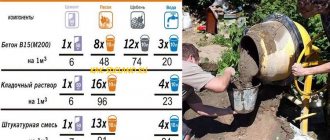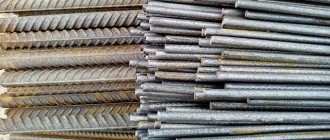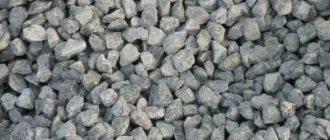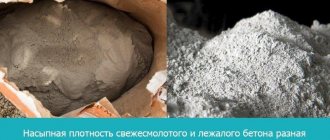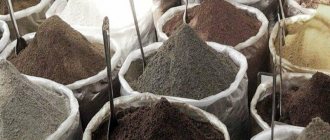Cement is one of the most popular materials in the construction market. It is a binding powder for the preparation of mortar and various products. In its production, clinker, gypsum, limestone and various mineral additives are used. The technical characteristics of cement powder depend on the characteristics of the composition and percentage of certain components.
Today, one of the most popular of all building materials is Portland cement. It has unique characteristics and has a wide range of applications. This type of mixture is used to prepare special solutions for repair and restoration work, for the production of mixtures for brickwork, and for the production of reinforced concrete products. Portland cement is used in all areas of construction: from civil to aviation.
Cement grades according to GOST 31108
The new standard was developed in 2003 to harmonize the current labeling with that adopted in the EU countries. At the moment, the latest version from 2016 is working. As usual, the previous standard has not been canceled - both work in parallel.
Labeling can also be mixed
Name and material composition
In a new way, cement grades are determined by their material composition. The marking contains three Cyrillic letters - TsEM and Latin numbers behind them. The composition is encrypted in Latin numerals:
- The abbreviation CEM I stands for Portland cement. There can be no additives in it. It consists only of ground burnt clinker and technological additives in an amount of no more than 5% by weight.
- CEM II - Portland cement with mineral additives. The mass fraction of additives is from 6% to 35%. Based on the number of additives, they are divided into two groups: group A with a content of 6% to 20%;
- group B indicates that additives were introduced from 21% to 35%.
Imported cement is marked according to the same principle, only the letters CEM are in front - from the English “cement”
- A - from 6% to 20%;
Cement from CEM II to CEM V can have subtypes depending on the additives. They are designated by the Latin letters A, B and C. After the group designation, put a slash, followed by a letter indicating the type of additive, then, separated by a dash, the letter used to code the additive itself. For example, TsEM N/A-I. If there are several additives, their designation is indicated by a dash, and the entire group is placed in brackets: for example: CEM IV/A (P-Z-Mk).
Additives in the composition
Additives and the designation of concrete grades with them are in the table. As you can see, CEM I is made only from crushed clinker with a small amount (no more than 5%) of technological substances. The second group of Portland cement has the most modifications and varieties.
Brands of Portland cement depending on additives in the composition
Portland slag cement and lower grades of cement also have additives, but the variations are much smaller. All additives and additives in the labeling are displayed in capital letters:
- Ш - granulated slag;
- Mk - microsilica;
- P - pozzolana;
- G - gliezh;
- Z - ash;
- C - burnt slate;
- And - limestone.
Cement grades depending on the composition of additives
Pure Portland cement - CEM I, always comes without additional components, since, by definition, it cannot have them. Let's look at a few examples of labeling of other brands of cement. If we see CEM II/V-SH. This means that we have Portland cement of the second type, that is, with additives. This is indicated by the letters that appear after the slash. The letter “B” indicates that the amount of additives is more than 21%, and the letter “W” indicates that slag was used. The inscription CEM III/C denotes Portland slag cement with the addition of burnt shale. In general, the way to decipher the markings is probably clear.
Compressive strength class
In the new standard, the composition must indicate the compressive strength that this brand of cement is able to provide. According to GOST, there are only three values:
- 22.5 N;
- 32.5 N;
- 42.5 N;
- 52.5 N.
Designation and rate of strength development according to the standard for different grades of cement
Strength is checked on 2, 7 and 28 days. Almost all cements are checked 7 days after mixing, and CEM III (slag Portland cement) is checked after 2 days. Based on the hardening speed, the grade of cement can be:
- normal-hardening - indicated by the letter N after the compressive strength class;
- slow-hardening - M;
- fast-hardening - B.
Graph of cement strength gain according to the new standard in mPa.
All this information is displayed in the marking. For example: CEM III/V-SH 32.5M. Designates Portland slag cement with type B additives - granulated slag, compressive strength 32.5 M, slow-hardening.
Cement production
The mixture of clay and limestone is heated to 1450 °C, resulting in the formation of individual clinker granules, which will then be mixed with gypsum to form cement. Mineral components can be added to it, which reduce the cost of the final building material and improve its resistance to acids, cold and other types of exposure.
In Ancient Rome, particles of volcanic ash found near Vesuvius and the Eifel were added to cement.
After the collapse of the Roman Empire, cement continued to be used, but the technology for producing a material with unique properties was lost
What does the grade of cement mean according to the old GOST
The old standard has more types of cement. All of them are shown in the table. The most popular two brands are ShPTs and PTs. Accordingly, slag Portland cement and ordinary cement. The marking is simple - after the abbreviation there is a three-digit number. This is a brand that indicates compressive strength in kilograms per square centimeter (kg/cm²). For example, PTs 400, ShPTs 300, PTs 500. PTs 550, 600 and 700 are much less common and used. They are used for special construction conditions.
An example of cement marking according to the old standard
In the marking of Portland cement, the brand is followed by the letter “D”, which stands for “additives” and then a number from 0 to 20. The number indicates the percentage of additives, respectively D0 is no additives, D20 is 20%. Granulated blast furnace slag is usually used as an additive. For example, PC 400 D15. It says that cement contains 15% slag additives.
Designation of cement composition according to old GOST
There is, by definition, more slag in the ShPC. According to GOST, it contains from 21% to 85% of this substance and therefore ShPC cannot withstand more than 300 kg/cm². This is the cheapest brand of cement in existence, which is used for the production of low-grade concrete - M100, 150 or 200. And then, if you look at the recommendations, for the preparation of a solution of the M200 brand, M400 cement is recommended, and the acceptable grades are M300 and M500. However, slag Portland cement is used in everyday life - for screed, if its high strength is not required, for pouring concrete preparation when laying a floor on the ground.
In private households, the most popular brand of cement is PC 400. It is optimal in strength. From this cement you can make a mortar from M200 to M350. These brands are the most widely used. Higher ones are used for multi-story and special construction.
Types of cement
Cement is divided into 6 types:
1. Roman cement (Roman cement) – cement in which belit (calcium silicate) predominates. It hardens for a very long time, which is why it is practically not used or produced in the modern world.
2. Portland cement is the most common cement that is most often used in construction. It is named after the English island of Portland for its color, which is similar to the color of the stones mined on this island.
3. Aluminous cement is an expensive building material. It is characterized by high hardening speed and strength. It is used for the rapid construction of buildings, as well as for the creation of buildings for strategic and military purposes.
4. Magnesia cement (aka Sorel Cement). Named after the French physicist and engineer Stanislas Sorel, who invented this type of cement in 1866. Characterized by high hardening speed and strength. Disadvantages: it deteriorates quickly, especially when exposed to water.
5. Mixed cement is the general name for all cements mixed with slag, pumice, tuff and other substances. It is characterized by: rapid hardening, low cost and low strength.
6. Acid-resistant cement . It contains sodium and quartz sand. The main feature is immunity to acids. Used in the chemical industry for the construction of buildings, fastening equipment and facing materials.
Colored cement is used to make decorative elements
Compliance with old and new cement markings
There cannot be an exact match, since the new standard provides a more complete decoding of the composition. Comparisons can only be made based on strength and the total number of additives.
If we compare the number of additives, we see the following picture.
- Those brands of PC that have zero amount of additives (D0) or no more than 5% of them correspond to the new brand of cement - CEM I. That is, PC400 D0 to D5 and PC500 D0-D5 will both be labeled CEM I. But it will only stand further a different number that indicates the compressive strength class.
- All Portland cement produced according to the old standard with an amount of additives greater than 5% will be classified as the second type according to the new marking. That is, PC 400 D10 or PC 500 D20 is equivalent to CEM II. Since according to the old GOST the amount of additives is no more than 20%, all brands will belong to subtype A.
- Portland slag cement ShPTs is redesignated as CEM III.
New cement markings: interpretation and possible meanings
We have sorted out the correspondence between the types of concrete according to the old and new markings. At least with the most popular brands. And the correspondence between the old brands and the new ones in terms of strength is as follows:
- M300 corresponds to 22.5 N;
- M400 - 32.5 N;
- M500 - 42.5 N;
- M600 - 52.5 N.
Now everything is clear even with new designations.
Now we can give an exact correspondence between old and new brands of cement using examples:
- PC400 D5 - CEM I 32.5
- PC400 D15 – CEM II/A-Sh 32.5
- PC500 D0 - CEM I 42.5
- PC500 D20 – TsEM I/A-Sh 42.5
- ShPTs 300 – TsEM III 22.5
It's not that difficult. New brands indicate a more precise composition and amount of additives that affect the characteristics. The rate of hardening may also be indicated. In general, if you know the decoding, it is more convenient to select the right brand.
Production features and characteristics
Immediately after the cement has been produced, the manufacturer sends the resulting samples to the laboratory where the research is carried out. Each batch must undergo this procedure to ensure the required properties. As a result, a conclusion is made whether the substance meets the declared characteristics and what labeling it can be assigned. In most cases, cement marking is determined by the conditions of GOST 10178-85.
The finished products are packaged, and the following information is displayed on the packaging itself:
- product name (abbreviation);
- strength (indication of the class in the form of an alphanumeric expression, for example, M500);
- percentage of additives contained (for example, D0);
- special properties (for example, quick-hardening - B);
- link to the document that was taken into account during production (TU, GOST, etc.).
The cement mixture can be improved thanks to various additives, giving it various properties:
- fast setting;
- sulfate resistance;
- ability to work at sub-zero temperatures;
- waterproof;
- use in combination with facing materials;
- and so on.
The finished product has the following characteristics:
- Strength, that is, the ability to withstand a certain mechanical load.
- Setting time is an equally important parameter on which the speed of work performed depends. To reduce the hardening time, various additives (gypsum, etc.) are used.
- Frost resistance is an indicator that includes the number of freezing and thawing cycles. To improve this property, sodium abietate or wood pitch is added.
